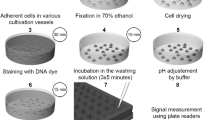Synopsis
Bearing in mind the numerous advantages offered by fluorescence measurements, in particular their greater sensitivity as compared with absorption cytophotometry, the possibility of measuring cellular DNA using the conventional Feulgen reaction in cytofluorometry has been studied. By means of a series of direct and indirect comparisons, it is shown that the data obtained by conventional Feulgen reaction cytofluorometry are equivalent to those obtained by integrating microdensitometry, provided that the following experimental conditions are observed:
-
(1)
The extinction of the preparations should not exceed 0.1. In general, extinction values lower than 0.1 can be obtained by hydrolysing for the usual times, by using a 0.01% Schiff reagent and 480 nm as the excitation wavelength.
-
(2)
The spectral zones subject to inner filter effects are excluded from the measurements, by employing barrier filters RG 630, RG 665 and RG 695, depending on the case.
-
(3)
The error due to photo-decomposition is eliminated or reduced by operational devices (which are described).
General aspects of fluorescence quantitation, whether or not the inner filter effect is present, are discussed. Certain special characteristics of an original fully-digitalized electronic instrumentation for high-sensitivity cytofluorometry and cytospectrofluorometry by multi-channel scaling and single photon detection, are also illustrated.
Similar content being viewed by others
References
Böhm, N. &Sprenger, E. (1968). Fluorescence cytophotometry: A valuable method for the quantitative determination of nuclear Feulgen-DNA.Histochemie 16, 100–18.
Cova, S., Prenna, G. & Mazzini, G. (1972). Microspectrofluorometry by single photon multiscaling.Abstracts of 4th International Congress of Histochemistry and Cytochemistry, Kyoto, pp. 161–2.
Cova, S., Prenna, G. &Mazzini, G. (1974). Digital microscpectrofluorometry by multichannel scaling and single photon detection.Histochem. J. 6, 279–99.
Decosse, J. J. &Aiello, N. (1966). Feulgen hydrolysis: Effects of acid and temperature.J. Histochem. Cytochem. 14, 601–4.
Deeley, E. M. (1955). An integrating microdensitometer for biological cells.J. Sci. Instrum. 32, 263–7.
Itikawa, O. &Ogura, Y. (1954). Simplified manufacture and histochemical use of the Schiff reagent.Stain Technol. 29, 9–11.
Nitsch, B., Murken, J. D. &Brück, H. J. (1970). Determining Feulgen-DNA of individual chromosomes by fluorescence cytophotometry with incident light.Histochemie 23, 254–65.
Ornstein, L., Mautner, W., Davis, B. J. &Tamura, R. (1957). New horizons in fluorescence microscopy.J. Mt. Sinai Hosp. 24, 1066–78.
Perrin, F. (1923). Observations sur la fluorescence.C. r. Lebd. Séanc. Acad. Sci. Paris 177, 469–75.
Ploem, J. S. (1967). The use of vertical illuminator with interchangeable dichroic mirrors for fluorescence microscopy with incident light.Z. wiss. Mikrosk. 68, 129–42.
Prenna, G. (1964). Caratteristiche del [2′-(p-amino-fenil)-6-metil-2,6′-bibenzotiazolo]-SO2, un nuovo reagente tipo Schiff fluorescente ad elevata sensibilità.Riv. Istoch. norm. pat. 10, 469–74.
Prenna, G. (1968). Qualitative and quantitative applications of fluorescent Schiff-type reagents.Mikroskopie 23, 150–4.
Prenna, G. &Bianchi, U. A. (1964). Reazioni di Feulgen fluorescenti e loro possibilità citofluorometriche quantitative. 5) Citofotometria quantitativa in fluorescenza ed in assorbimento della reazione di Feulgen eseguita con acriflavina-SO2.Riv. Istoch. norm. pat. 10, 667–76.
Prenna, G. &De Paoli, A. M. (1964a). La deidrotio-p-toluidina-SO2, un nuovo reagente tipo Schiff altamente fluorescente.Riv. Istoch. norm. pat. 10, 185–6.
Frenna, G. &De Paoli, A. M. (1964b). Derivati tiazolici come reagenti tipo Schiff fluorescenti.Istituto Lombardo (Rend. Sci.) B 98, 267–73.
Prenna, G. &De Paoli, A. M. (1968). Impiego del Rivanol come reagente tipo Schiff fluorescente nella reazione di Feulgen.Riv. Istoch. norm. pat. 14, 169–70.
Prenna, G., Leiva, S. &Mazzini, G. (1971). Determinazione citofluorometrica del contenuto nucleare di DNA per mezzo della reazione di Feulgen convenzionale.Riv. Istoch. norm. pat. 17, 322–3.
Prenna, G., Leiva, S. & Mazzini, G. (1972). Quantitative DNA-cytofluorometry by the conventional Feulgen reaction.4th International Congress of Histochemistry and Cytochemistry, Kyoto, pp. 201–2.
Prenna, G., Mazzini, G. &Cova, S. (1974). Methodological and instrumentational aspects of cytofluorometry.Histochem. J. 6, 259–78.
Prenna, G. &Sacchi, S. (1964). Possibilità d'esame in fluorescenza della reazione acido periodico-Schiff convenzionale (fucsina basica-SO2). Osservazioni sulle fibre elastiche nel derma umano.Boll. Soc. Med.-Chir. Pavia 78, 779–90.
Rigler, R. Jr. (1966). Microfluorometric characterization of intracellular nucleic acids and nucleo proteins by Acridine Orange.Acta physiol. scand. 67, Suppl. 267, 1–122.
Rosanov, Ju. M. &Kudryavtsev, B. N. (1967). A method of fluorescent cytophotometry for the purpose of a quantitative determination of DNA.Tsitologiya,9, 361–7 [in Russian].
Ruch, F. (1966). Determination of DNA content by microfluorometry. In:Introduction to Quantitative Cytochemistry (ed. G. L. Wied), pp. 281–94. New York & London: Academic Press.
Ruch, F. (1970). Principles and some applications of cytofluorometry. In:Introduction to Quantitative Cytochemistry, Vol. II (eds. G. L. Wied & G. F. Bahr), pp. 431–50. New York & London: Academic Press.
Sacchi, C. A., Svelto, O. &Prenna, G. (1974). Pulsed tunable lasers in cytofluorometry.Histochem J. 6, 251–8.
Stoward, P. J. (1967). Studies in fluorescence histochemistry. II) The demonstration of periodate-reactive mucosubstances with pseudo-Schiff reagents.J. R. microsc. Soc. 86, 237–46.
Thaer, A. A. (1966). Instrumentation for microfluorometry. In:Introduction to Quantitative Cytochemistry (ed. G. L. Wied), pp. 409–26. New York & London: Academic Press.
Vialli, M. &Prenna, G. (1969). Contribution to the cytospectrofluorometric measurement of 5-hydroxytryptamine in enterochromaffin cells.J. Histochem. Cytochem. 15, 321–30.
Author information
Authors and Affiliations
Additional information
Invited paper at the ‘Conference on Quantitative Fluorescence Techniques as Applied in Cell Biology’, organized by the Battelle Institute, Seattle, 27–31 March 1972.
Rights and permissions
About this article
Cite this article
Prenna, G., Leiva, S. & Mazzini, G. Quantitation of DNA by cytofluorometry of the conventional Feulgen reaction. Histochem J 6, 467–489 (1974). https://doi.org/10.1007/BF01003265
Received:
Issue Date:
DOI: https://doi.org/10.1007/BF01003265




